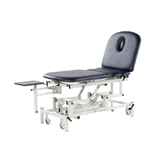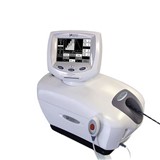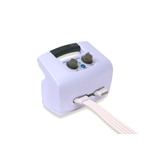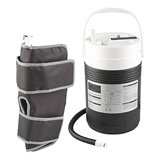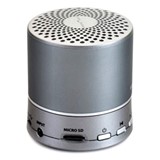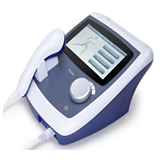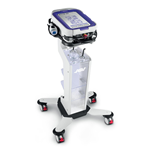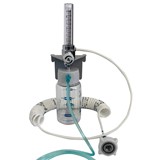The technique of traction applies a longitudinal force to the spine and associated structures, assisting the nucleus pulposus to retract back into the disc, with the aim of relieving compression and irritation of the nerve roots.
While many systematic reviews suggest that traction, alone or in combination with other modalities, has little to no impact on clinical outcomes of pain and function, this should be reviewed and interpreted with caution. While the effectiveness of traction therapy has been questioned, some physicians are experiencing its benefits, with patients responding positively to traction treatment. A UK survey with a sample of 1239 physiotherapists with 507 participants using lumbar traction therapy, showed that over 60% of these users disagreed with recommendations made in research against traction therapy, while another 25% were undecided (1). Additionally, a US survey performed in 2013 on physical therapists revealed that a majority of respondents (76.6% of 1001 respondents) utilised traction therapy in practice, with most using it as one component of their patients treatment plan (2).
The discrepancy between the published guidelines and the common use of traction therapy in clinic may result from too much variance between trials. Factors such as the types of traction used, this being mechanical or manual traction therapy, the deliverability of treatment including the length of sessions, the number of sessions performed and the rhythm and amount of traction force, may result in different clinical outcomes. This variance highlights the need for high quality RCTs and standardised traction protocols and delivery methods to make a definitive conclusion of the effectiveness in traction therapy as a modality.
Anecdotal evidence provides an explanation for the high rates of use, with many clinicians observing positive response in their patients treatment plan when incorporated with traction therapy.
Dr. George Michael, Senior Osteopath for the Centre of Musculoskeletal Medicine in Melbourne, uses a combined approach with High Power Laser therapy and traction therapy in his treatment of discogenic neck pain. He finds this approach reduces pain and improves function to allow patients to continue on with daily activities.
"We do Laser therapy for 5-10 minutes, then we place the patient in cervical traction and it feeds in quite nicely. Their muscles are relaxed, pain has decreased, healing has already started and it just works beautifully when you combine them together."
Dr. George Michael
About Chattanooga Mechanical Traction Units
With over 40 years of design and manufacturing expertise, Chattanooga introduces the next generation of distraction treatment systems.
These devices provide traction and mobilisation of skeletal structures and skeletal muscles for the relief of peripheral radiation, sciatica and pain. The device achieves its effects through mechanical traction of intervertebral discs, that is, unloading due to distraction and positioning. When pain is relieved by static stretching, the muscle activity is also reduced, which can be demonstrated by quantitative electromyography.
Clinical Indications:
- Protruding discs
- Spinal root impingement
- Bulging discs
- Hypomobility
- Herniated discs
- Degenerative joint disease
- Degenerative disc disease
- Prolapsed discs
- Facet syndrome
- Posterior facet syndrome
- Compressions fracture
- Acute facet problems
- Joint pain
- Radicular pain
- Discogenic pain
Chattanooga Triton 6M Table
- 6-section treatment table provides maximum patient comfort in prone and supine positions for manual and traction therapy
-
Pelvic tilt section can be adjusted from 0° to 15° to provide flexion of lumbar spine and to help address pelvic asymmetry
-
Head piece can be repositioned from -15° to +40° to allow easy access to thoracic and cervical spine
-
Tuck-away grab bars for hanging traction without thoracic restraint
-
Leg section is adjustable from 0° to 45°
-
Gas springs assist in friction-free movement of head, pelvic, chest and leg sections which are easily accessible from either side of the table
-
Foot/hand controller allows easy adjustment of table height and includes a lockable safety mechanism
-
Complete range of accessories to suit every patient need
Chattanooga Triton Traction Unit with EMG Module
Features:
- Static, intermittent, and cycling traction
-
Independent timers allow easy customisation of traction pulls in progressive, regressive, and traction phases
-
Variable speed motor (30%, 50% and 100%)
-
Pretension step eases the patient into traction to prevent muscle guarding and pretest patient’s tolerance to traction force
-
Clinical Protocols provided for both cervical and lumbar conditions
-
Full-color graphic library complete with visual tutorial of belting techniques, anatomical images and common pathologies
- Digital high-resolution color touch screen that pivots 270º
- 80 User-defined protocol slots
-
Easily store treatment parameters, pain scales, and pain maps on Patient Data Cards
References
- Harte, A. A., Gracey, J. H., & Baxter, G. D. (2005). Current use of lumbar traction in the management of low back pain: results of a survey of physiotherapists in the United Kingdom. Archives of physical medicine and rehabilitation, 86(6), 1164–1169. https://doi.org/10.1016/j.apmr.2004.11.040
- Madson, T. J., & Hollman, J. H. (2015). Lumbar Traction for Managing Low Back Pain: A Survey of Physical Therapists in the United States. Journal of Orthopaedic & Sports Physical Therapy, 45(8), 586–595. https://doi.org/10.2519/jospt.2015.6036










